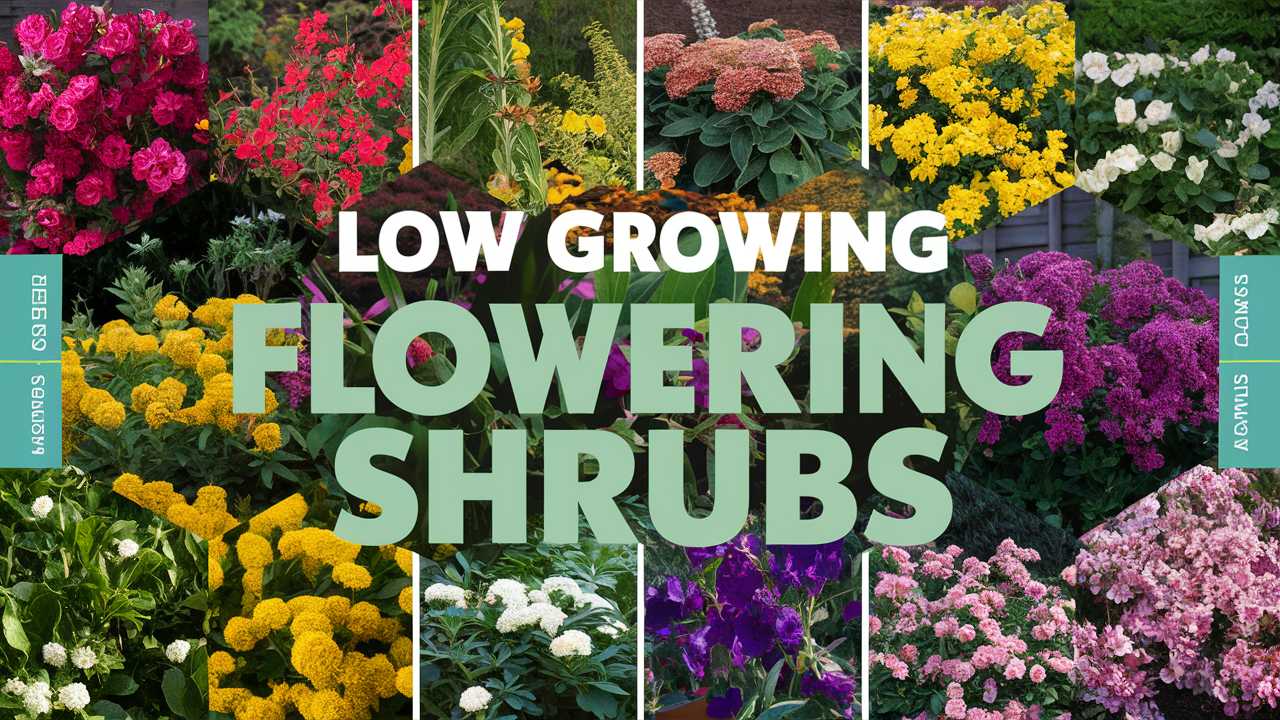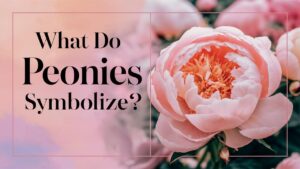In this guide, we will explore a variety of low-growing flowering shrubs, highlighting their unique characteristics, care tips, and the stunning impact they can have in your garden.
Japanese Pieris (Pieris japonica ‘Cavatine’)
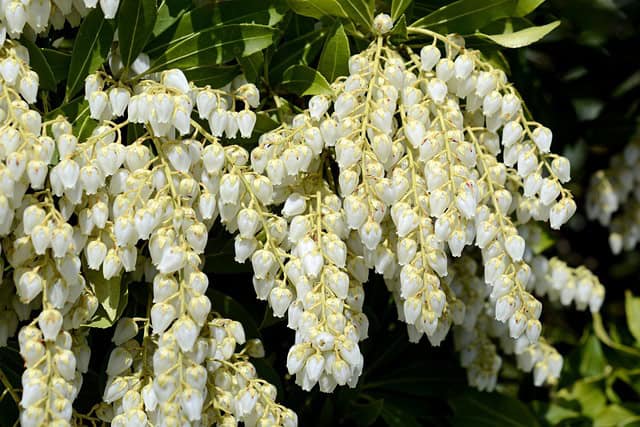
Japanese Pieris ‘Cavatine’ is a compact evergreen shrub that captivates the eye with its glossy green leaves and stunning pink buds that bloom into white flowers in early spring. This delightful bloom serves as an awakening herald for the garden, bringing an infusion of life after a long winter.
Ideal for partial shade, this variety of Pieris thrives in moist, acidic soil, making it perfect for planting near azaleas or rhododendrons. Its growth habit is neat and tidy, reaching only about 2 to 3 feet in height, making it an excellent choice for borders or mixed plantings. With minimal pruning required, ‘Cavatine’ provides low maintenance paired with visual rewards, ensuring it remains a favorite among floral enthusiasts.
Rhododendron ‘Ramapo’
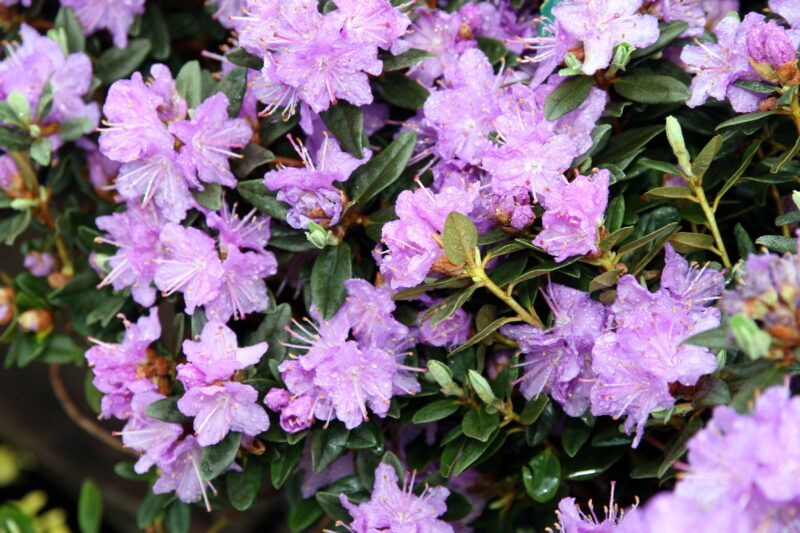
Rhododendron ‘Ramapo’ is a beloved dwarf evergreen shrub renowned for its vibrant purple blooms, which pop against its deep green foliage. Reaching heights of just 2-3 feet and a similar spread, this low-growing rhododendron is perfect for small spaces or rock gardens.
Flowering in mid-spring, the ‘Ramapo’ is appreciated not only for its captivating flowers but also for its adaptability. It thrives best in acidic, well-drained soils and in partial shade. Its compact size makes it an ideal candidate for low-maintenance garden beds, providing an impactful seasonal display without the need for extensive upkeep.
Cotoneaster
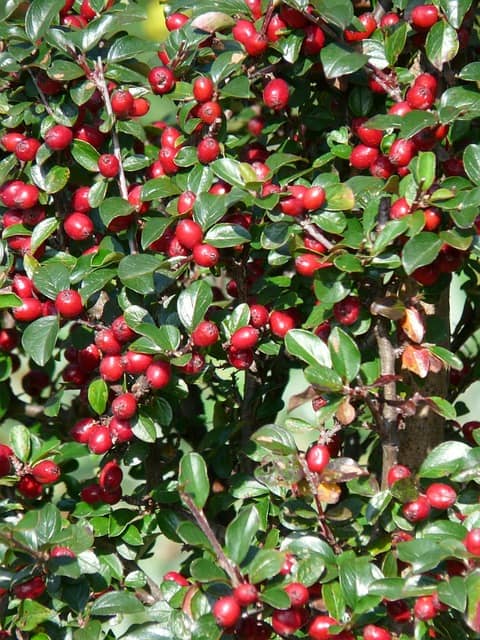
Cotoneaster is a diverse and resilient group of shrubs that vary widely in height and flowering characteristics, but the lower-growing varieties such as Cotoneaster dammeri stand out for their mat-forming growth habit and abundant spring blooms. The delicate pink flowers are a favorite for pollinators, attracting bees and butterflies to your garden.
These shrubs are particularly valued for their ability to thrive in a variety of soil types and conditions, resuming their vibrant green hue in summer before transitioning to fiery red and orange foliage in autumn. Cotoneaster is perfect for cascading over walls or in containers, promoting a soft and naturalistic landscape.
Potentilla (Potentilla fruticosa)
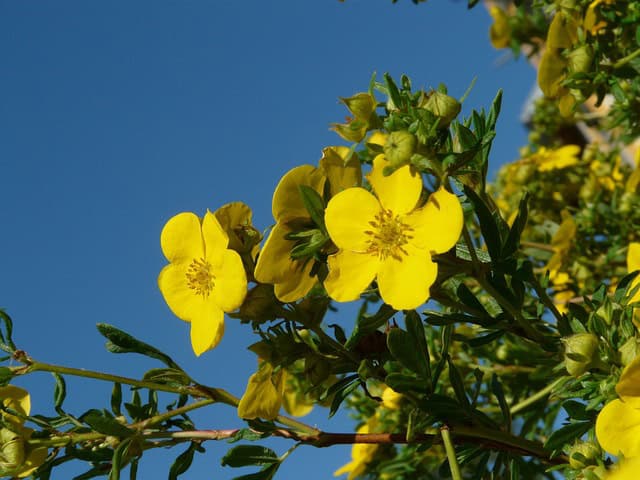
Potentilla fruticosa, or common potentilla, is an unsung hero in garden design. This low-growing shrub is known for its cheerful yellow flowers that create a breathtaking display from late spring to early fall. Potentilla thrives in full sun and is exceptionally tolerant of dry conditions, making it an excellent choice for xeriscaping or coastal gardens.
With a compact size of 1-3 feet, its rugged nature is perfect for gardens requiring durability. Potentilla is also deer-resistant, adding to its allure as a low-maintenance flowering shrub that can stand up to the elements while providing continuous blooms throughout the warm months.
Spirea (Spiraea)

Spirea is another versatile group of flowering shrubs that offers many options for the low-growing section of your landscape. Varieties such as Spirea japonica ‘Magic Carpet’ and Spiraea bumalda boast stunning clusters of pink or white flowers during the summer months.
These shrubs are perfect for creating mass plantings or filling in borders. They thrive in a variety of soil conditions and are adaptable to different light levels, with most preferring full sun for optimal blooming. Pruning is minimal, primarily done in late winter or early spring, making spireas a low-maintenance choice for colorful landscaping.
Japanese Skimmias (Skimmia Japonica)
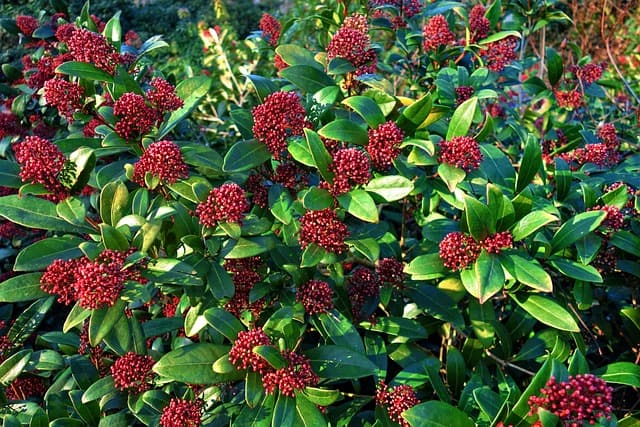
Japanese skimmia is a charming evergreen shrub that thrives in shady areas, offering aromatic blossoms in early spring. The small, white to creamy flowers develop into attractive red berries in the fall, providing year-round visual interest.
Growing to about 2-4 feet, Skimmia is perfect for adding a touch of elegance to shaded corners of the garden. It prefers moisture-retentive, well-drained soil and is highly resistant to pests, making it a wonderful addition to woodland gardens or mixed borders.
Winter Heath (Erica carnea)
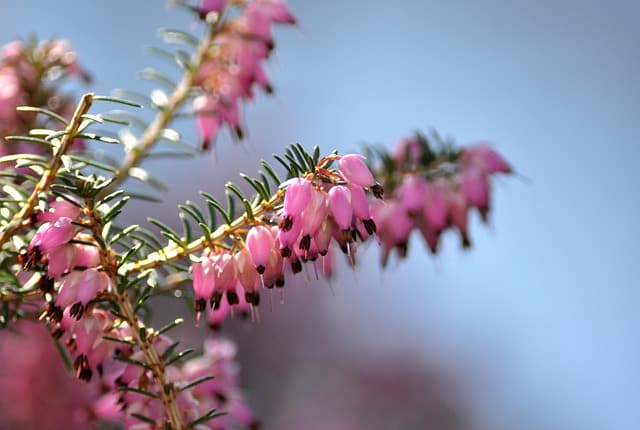
For those seeking early spring blooms, Winter Heath is a must. This hardy, low-growing shrub flourishes in small, hilly areas, producing lilac, pink, or white flowers that can often be seen as early as January. With a modest height of just 6 to 12 inches, Winter Heath is perfect for rock gardens or as a ground cover beneath trees.
This plant thrives in well-draining, acidic soil and does well in full sun to partial shade. Its low stature and early blooms make it a garden workhorse, providing visual appeal when much else is still dormant.
Bluebeard (Caryopteris x clandonensis)
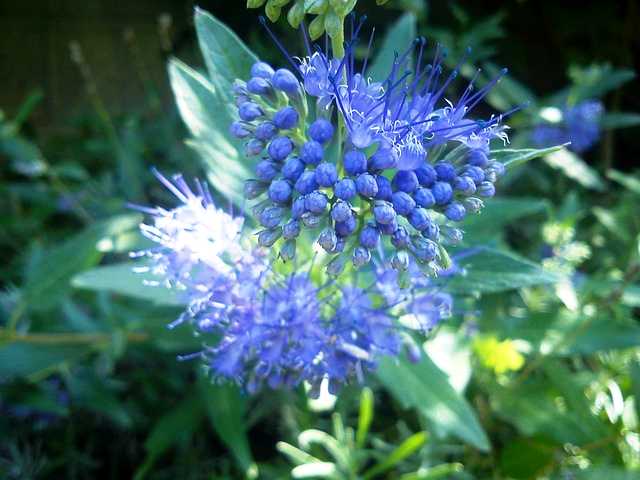
Bluebeard is a striking low-growing shrub that showcases stunning clusters of blue-purple flowers in late summer through fall. Caryopteris x clandonensis is well-loved for its ability to attract pollinators, particularly bees and butterflies.
This drought-tolerant shrub prefers full sun and adapts well to poor soils, making it an excellent choice for those looking to create an effortless, low-maintenance garden. With its aromatic foliage and vibrant flowers, Bluebeard makes for a delightful addition to any landscape, serving as a beautiful backdrop to other seasonal bloomers.
Virginia Sweetspire (Itea virginica)
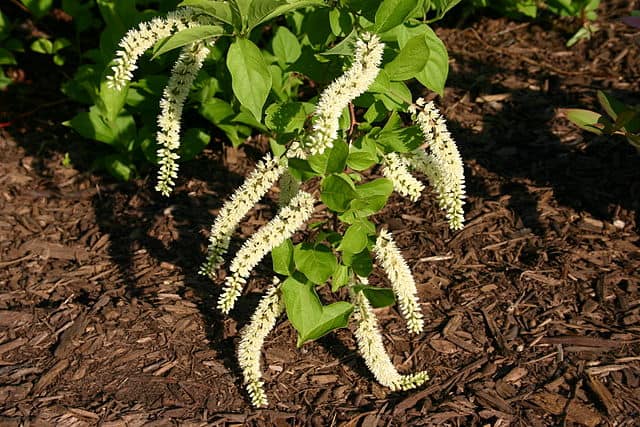
Virginia Sweetspire is a unique, deciduous shrub that offers a profusion of fragrant white flowers in the summer. Known for its ability to thrive in wet soils, Sweetspire is ideal for planting along rain gardens or in areas with poor drainage.
With a mature height of around 3 to 4 feet, this shrub’s arching branches are adorned with lush green foliage that transitions to gorgeous deep red and orange hues in the fall. Sweetspire is an excellent choice for adding seasonal interest to your landscape while appealing to both human and pollinator visitors.
Hummingbird Summersweet (Clethra alnifolia)
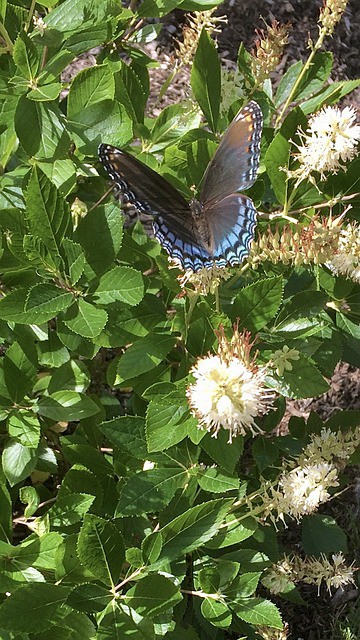
Hummingbird Summersweet is aptly named for its allure to hummingbirds and other pollinating species. This shrub produces dense, fragrant white flower spikes in the summer months, which attract not only hummingbirds but also butterflies.
Growing to heights of 3-5 feet, its lush foliage remains attractive throughout the growing season. Clethra alnifolia thrives in moist conditions and can tolerate a range of soil types, making it a show-stopping addition to any garden design. Its sweetness is not just in its name; it brings delight to all who visit and survey its beauty.
Butterfly Bush (Buddleja)
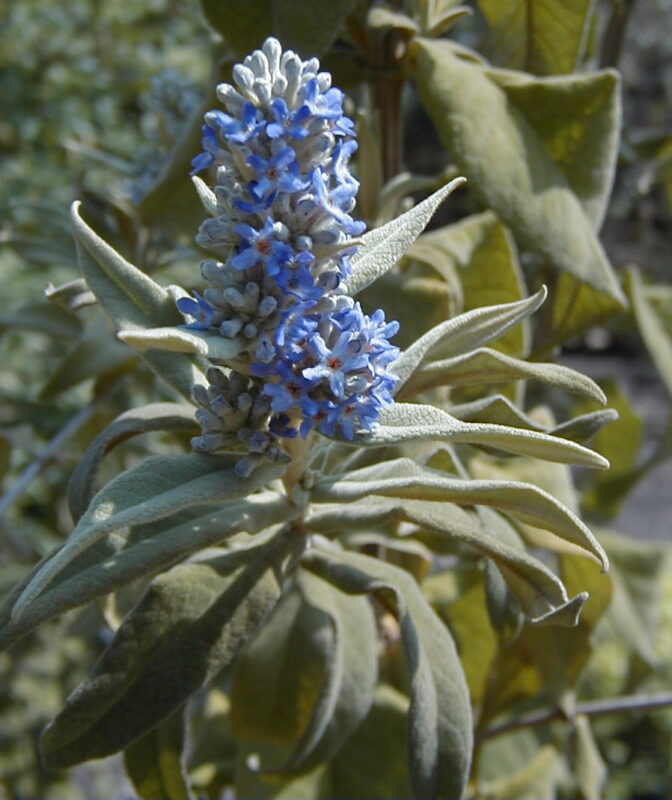
The Butterfly Bush (Buddleja) is known for its stunning clusters of flowers that come in a variety of colors, including purple, white, pink, and blue. These bushes can grow up to 3-5 feet tall but can be kept more compact with judicious pruning.
As its name suggests, it’s a magnet for butterflies, drawing them in throughout blooming seasons. Butterfly bushes thrive in full sun and well-drained soil, and they tolerate drought once established. Their vibrant blooms and fragrant petals make them a fantastic choice for a sunny garden border where wildlife is encouraged.
Hydrangea (Hydrangea macrophylla)
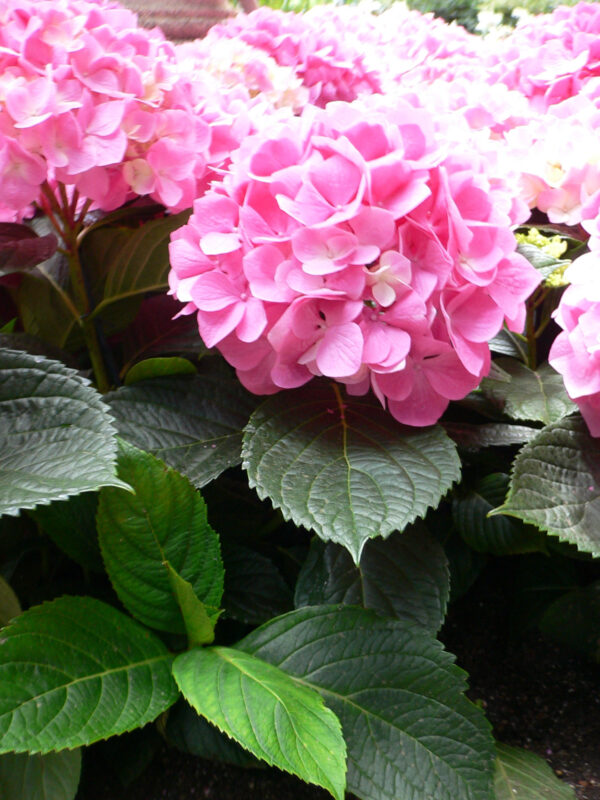
Hydrangea macrophylla is an iconic flowering shrub known for its stunning clusters of large blooms that can be blue, pink, or white, depending on soil conditions. This shrub typically reaches heights of about 3 to 6 feet but can be pruned to maintain a lower profile.
Flowering from summer to early fall, hydrangeas require a bit more attention to their watering needs but deliver spectacular results. Their ability to adapt to different soil types and conditions makes them a valuable addition to any garden. Planted as a standalone feature or grouped in clusters, Hydrangeas deliver a breathtaking impact.
Fothergilla (Fothergilla gardenii)
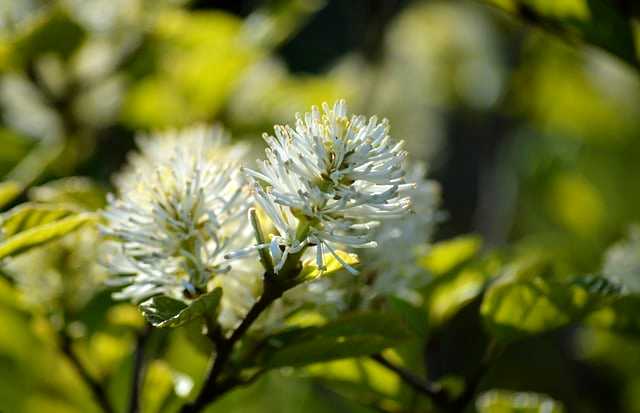
Fothergilla gardenii, or Dwarf Fothergilla, is a compact shrub that showcases stunning bottlebrush-like white flowers in early spring. Its considerable appeal is complemented by the incredible autumnal display when its foliage transforms into vibrant shades of yellow, orange, and red.
Reaching only about 2-3 feet in height, this shrub is ideal for smaller gardens or as a border planting. Fothergilla prefers acidic, moist soil and thrives in partial to full sun. Its beauty and aroma will captivate anyone who walks by, making it a worthy addition to your flowering shrub collection.
Ninebark (Physocarpus opulifolius)
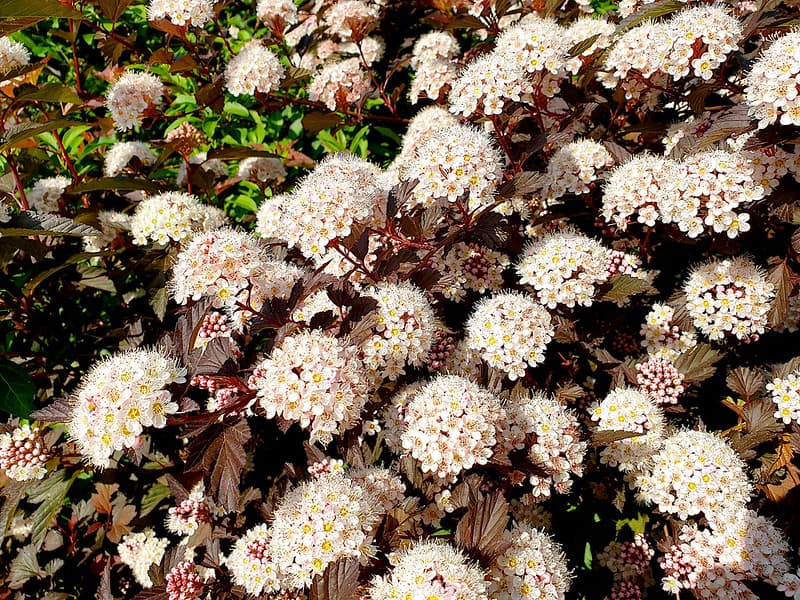
Ninebark is an adaptable flowering shrub with unique bark that peels away in layers, adding winter interest to the garden. As it matures, it grows 3-10 feet in height, but dwarf cultivar options like ‘Little Devil’ stay around 3 feet.
This shrub produces delicate clusters of white flowers in late spring, attracting beneficial insects. Ninebark prefers full sun and can tolerate a broad range of soil types, making it an excellent choice for low-maintenance landscapes. Given its hardy nature and visual appeal, it’s a fantastic candidate for privacy plantings or perennial gardens.
Lavender (Lavandula)
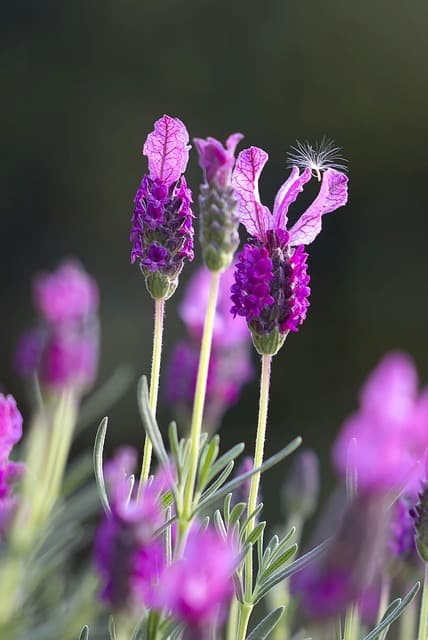
Lavender isn’t simply an aromatic herb; it can also be a low-growing shrub that offers stunning floral displays. With its silvery-green foliage and spikes of purple flowers, lavender provides a delightful scent and a charming aesthetic.
Generally growing to about 2-3 feet, lavender thrives in well-drained soil and loves full sun. It’s drought-tolerant once established, which makes it an ideal option for more arid gardens. Additionally, its ability to attract bees and butterflies positions it as a beneficial plant in any pollinator-friendly garden.
Lilac (Syringa)
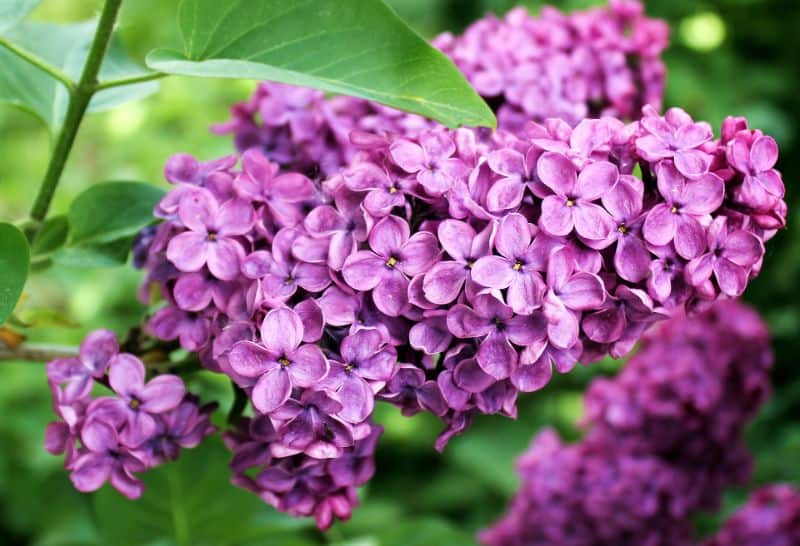
Lilacs are well-known for their fragrant blossoms and beautiful hues, and low-growing varieties such as Syringa meyeri ‘Palibin’ reach a charming height of only 3-4 feet. They bloom in early spring, painting the landscape with soft, delightful shades of purple and white.
While they prefer full sun and well-drained soil, lilacs are hardy plants that can adapt to various conditions. Their sweet scent is a nostalgic reminder of spring, making them beloved by gardeners looking to evoke the history and charm of traditional gardens.
Azalea (Rhododendron spp.)
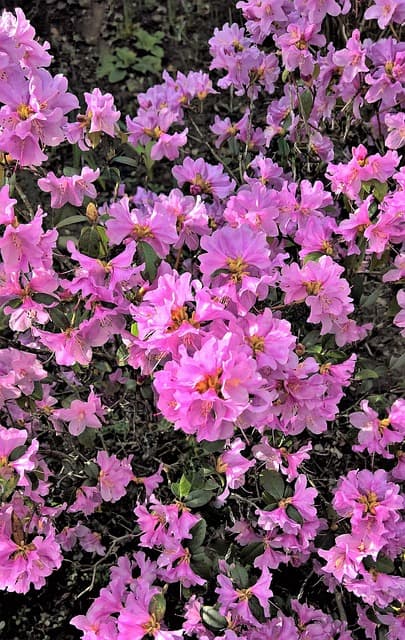
Azaleas are popular flowering shrubs valued for their exuberant spring blooms. Low-growing varieties like the dwarf azalea can maintain a height of just 1 to 2 feet while providing a captivating display of pink, red, white, or purple flowers.
These vibrant shrubs thrive best in well-drained, acidic soil and should be planted in partial shade or filtered sunlight. Their ability to create stunning and impactful color spots makes azaleas a favored choice for mixed borders or as focal points in smaller gardens.
Forsythia
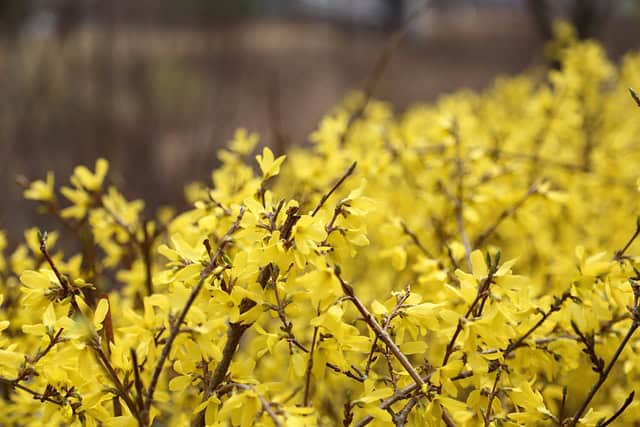
Forsythia is one of the early spring bloomers, showcasing golden-yellow flowers that bloom even before the leaves appear. With their arching stems, dwarf forsythia varieties like ‘Mini Gold’ grow to about 2-3 feet.
Best placed in full sun, these shrubs are hardy and adaptable, requiring little maintenance beyond a yearly pruning after flowering. Their cheerful blooms bring a wave of warmth and promise of brighter days, making forsythia a garden staple.
Indian Hawthorn (Rhaphiolepis indica)
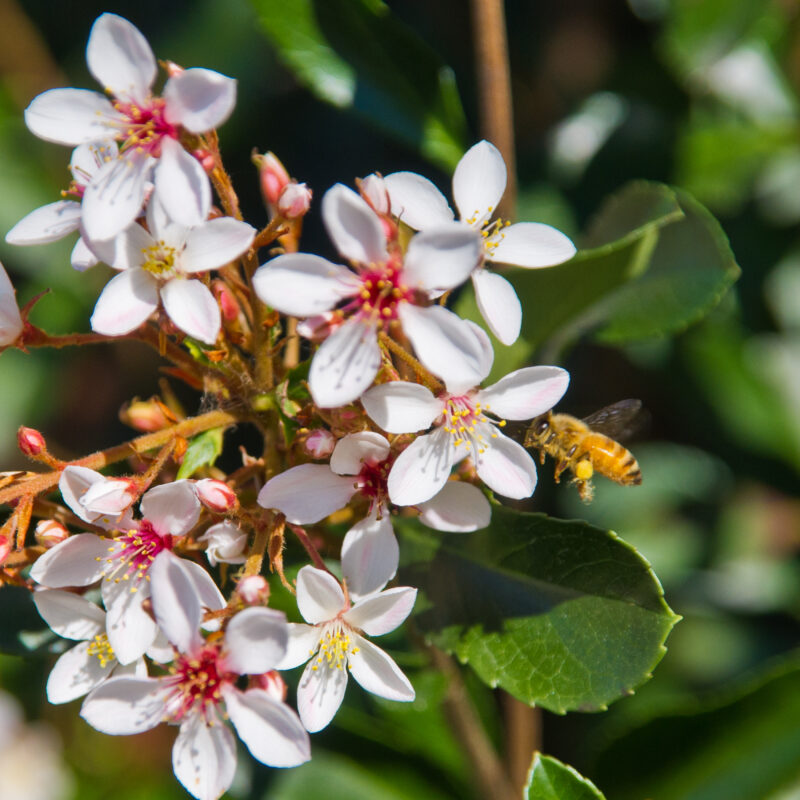
Indian Hawthorn is a versatile low-growing shrub that can grow between 2 to 4 feet tall and is characterized by its dense, evergreen foliage and clusters of pink or white flowers in spring. This shrub is particularly popular in warmer regions, thriving in sunny landscapes.
The Indian Hawthorn’s resistance to pests and drought makes it low-maintenance, while its attractive berries after flowering provide visual interest in the fall and winter months. Ideal for foundation plantings or mixed borders, Indian Hawthorn offers both aesthetic value and practicality.
Viburnum
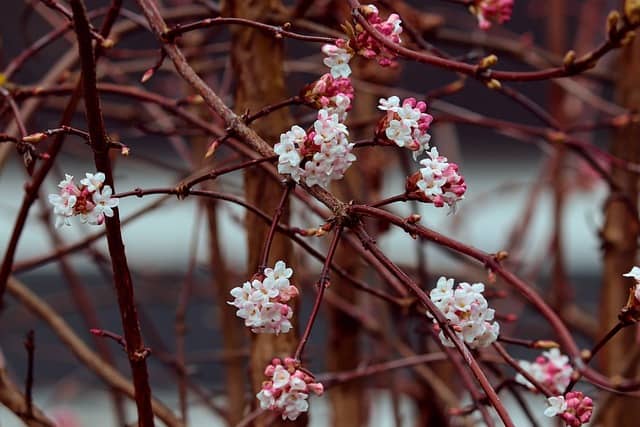
Viburnum includes many species that provide wonderful flowers and berries over an extended season. Low-growing varieties such as Viburnum opulus ‘Nanum’ typically reach just 2 to 3 feet tall.
These shrubs provide clusters of white flowers in late spring followed by colorful berries. Viburnum thrives in various soil conditions and light levels, making it adaptable and an excellent addition to nearly any garden space. Their ability to attract birds also enhances the ecological benefits they provide.
Shrub Roses (Rosa)
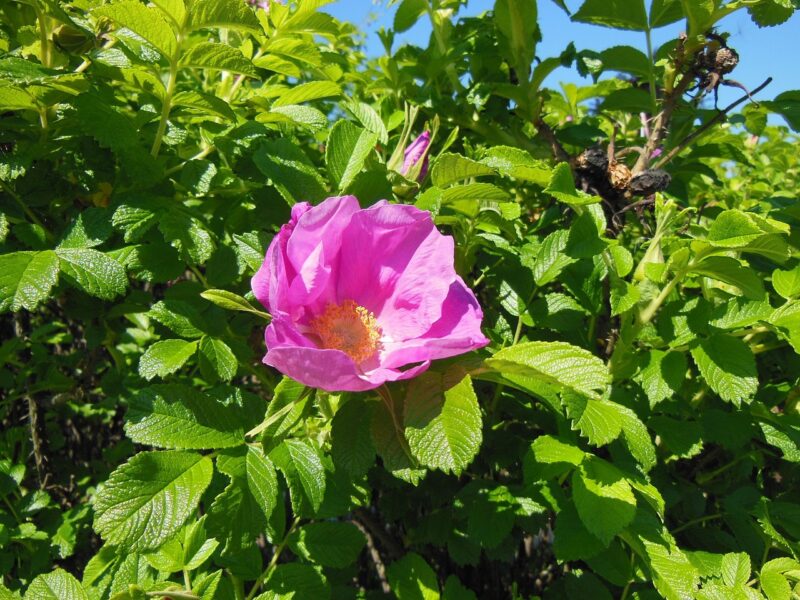
Dwarf shrub roses are perfect for those looking to combine beauty with ease of care. They typically range from 2 to 3 feet high and can produce a continuous display of colorful blooms from late spring until frost.
These shrubs prefer full sun and well-drained soils, offering fragrance and texture to gardens of all styles. Their resilience to disease and ability to bloom repeatedly make shrub roses a fantastic choice for low-maintenance flower beds or borders.
Dwarf Chenille (Acalypha Reptans)
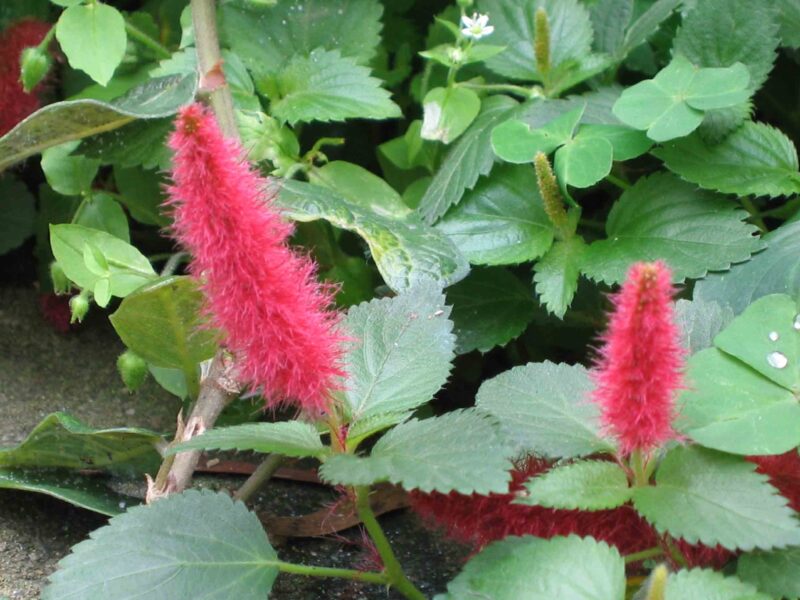
Dwarf Chenille, also known as the red-hot cat tail, is a stunning choice for those seeking something a bit different. This compact shrub grows about 1-2 feet tall and produces unique fuzzy, red flowers that offer a tropical feel to any landscape.
Dwarf Chenille prefers warm, sunny areas and well-drained soils. Its eye-catching appearance makes it a perfect candidate for tropical-themed gardens or as a standout in mixed plantings.
Dwarf Bottlebrush (Callistemon viminalis ‘Little John’)
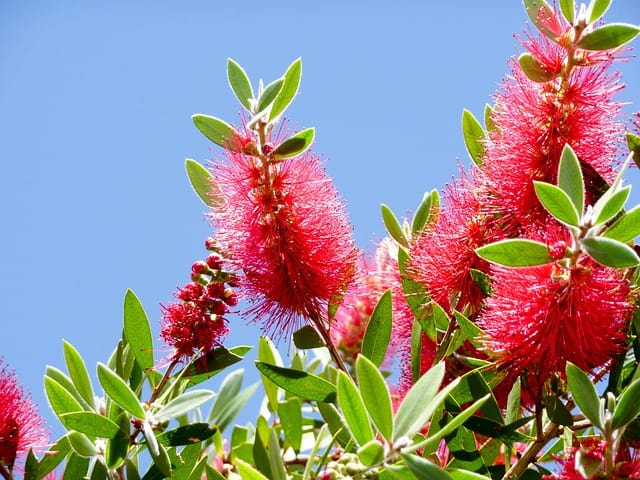
The Dwarf Bottlebrush shrub is a delightful addition to any garden, displaying bright red flower spikes that resemble a bottlebrush. Growing to about 2-3 feet, it is perfect for smaller garden spaces or for creating colorful borders.
This shrub thrives in full sun, requiring well-drained soil for optimal growth. Its drought-resistant nature once established makes it a low-maintenance option that attracts birds and pollinators, providing a vibrant focal point in the landscape.
Dwarf Crape Myrtle (Lagerstroemia indica)
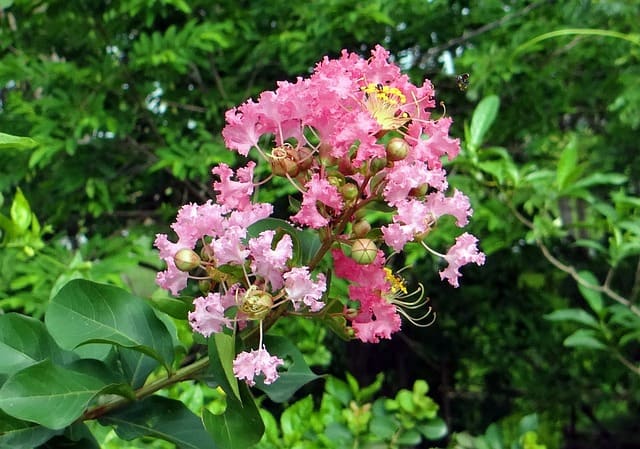
Dwarf Crape Myrtle is celebrated for its spectacular summer blooms and attractive bark. These shrubs can be found in many colors, including pink, white, and purple, and typically reach heights of 2-4 feet, making them suitable for small gardens.
They prefer full sun and well-drained soil, blooming from late spring to fall, providing a long-lasting display of color. The vibrant flowers compliment their stunning fall foliage, ensuring that dwarf crape myrtles are a highlight of any garden, from lush backyards to quaint landscapes.
Garland Flower (Daphne cneorum)
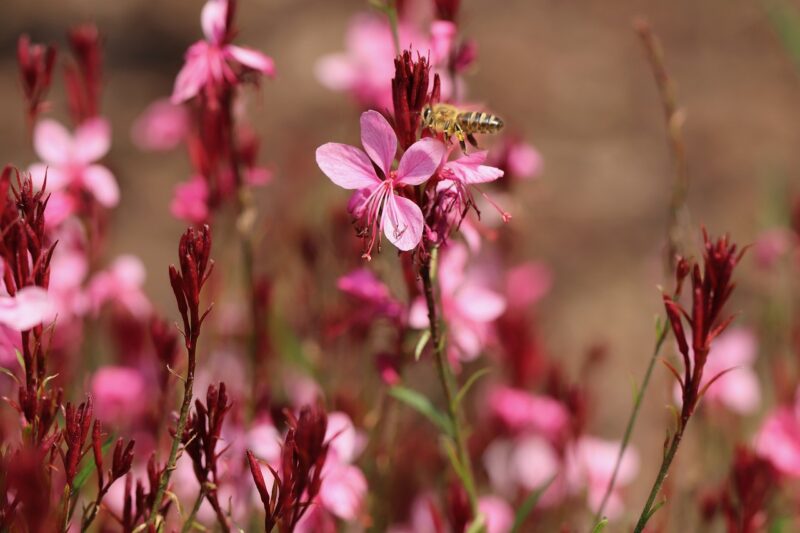
The Garland Flower is a charming little shrub that excels in full sun or partial shade. Its sweetly scented pink flowers bloom in spring, creating a symphony of perfume alongside a backdrop of evergreen leaves.
This low-growing beauty typically reaches only about 1-2 feet in height and prefers relatively well-drained soils. While it does require some attention to water needs, the reward of fragrant blooms makes Daphne a superb choice for small gardens or near pathways.
Mountain Laurel (Kalmia latifolia ‘Minuet’)

Dwarf Mountain Laurel varieties, such as ‘Minuet,’ bring exquisite beauty to the garden with their lovely clusters of pink and white blooms. This adaptable shrub grows only around 2-3 feet tall and thrives in acidic, well-drained soil.
Ideal for partially shaded locations, this shrub not only offers an attractive flower display in late spring but also tolerates varying moisture levels. The Mountain Laurel provides year-round foliage interest, making it a lovely component for woodland gardens.
St. John’s Wort (Hypericum x hidcoteense ‘Hidcote’)
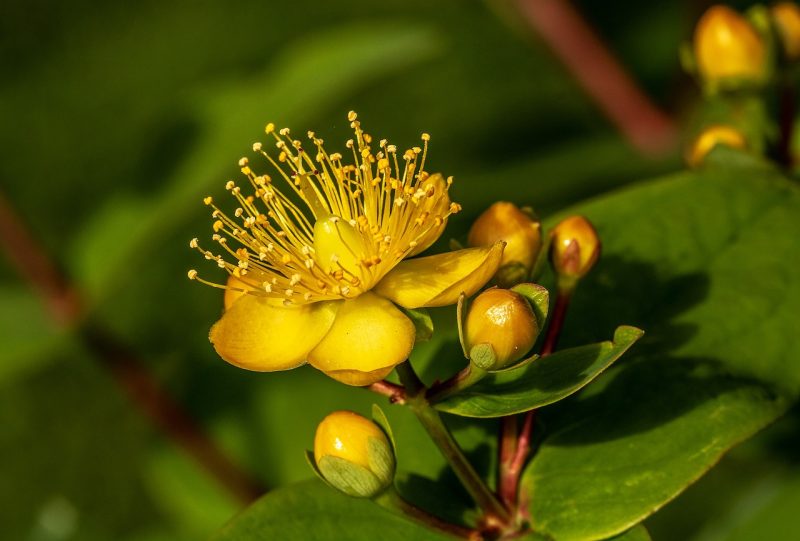
St. John’s Wort is a low-growing shrub that produces bright yellow flowers in summer. Varieties like ‘Hidcote’ grow to around 1-2 feet and enjoy full sun and well-drained soil.
This resilient shrub is not only attractive but also a hardy addition to the garden landscape, providing vibrant summer colors that attract butterflies and beneficial insects. Its adaptability makes St. John’s Wort a fabulous choice for low-maintenance gardens.
Fuchsia
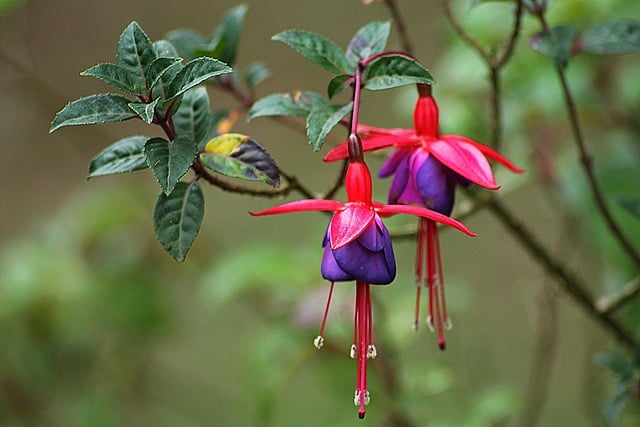
Fuchsia is a delightful flowering shrub known for its stunning, pendulous flowers resembling lanterns in shades ranging from magentas to blues. Although it can grow taller, compact varieties typically stay around 2-3 feet.
Fuchsia thrives in partially shaded areas, preferring moist, well-drained soil. Its lovely blooms attract bees, hummingbirds, and other pollinators, making it a wonderful addition to both cottage gardens and more modern landscapes. The combination of beauty and wildlife attraction makes Fuchsia a charming element of any garden.


